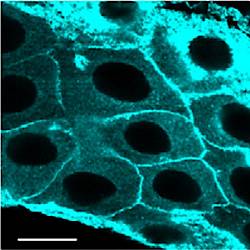Phosphorylation of the Smo tail is controlled by membrane localisation and is dispensable for clustering.
The Hedgehog (Hh) signalling cascade is highly conserved and involved in development and disease throughout evolution. Nevertheless, in comparison with other pathways, our mechanistic understanding of Hh signal transduction is remarkably incomplete. In the absence of ligand, the Hh receptor Patched (Ptc) represses the key signal transducer Smoothened (Smo) through an unknown mechanism. Hh binding to Ptc alleviates this repression, causing Smo redistribution to the plasma membrane, phosphorylation and opening of the Smo cytoplasmic tail, and Smo oligomerisation. However, the order and interdependence of these events is as yet poorly understood. We have mathematically modelled and simulated Smo activation for two alternative modes of pathway activation, with Ptc primarily affecting either Smo localisation or phosphorylation. Visualising Smo activation through a novel, fluorescence-based reporter allowed us to test these competing models. Here, we show that Smo localisation to the plasma membrane is sufficient for phosphorylation of the cytoplasmic tail in the presence of Ptc. Using fluorescence cross-correlation spectroscopy (FCCS), we also demonstrate that inactivation of Ptc by Hh induces Smo clustering irrespective of Smo phosphorylation. Our observations therefore support a model of Hh signal transduction whereby Smo subcellular localisation and not phosphorylation is the primary target of Ptc function.
Back to list
